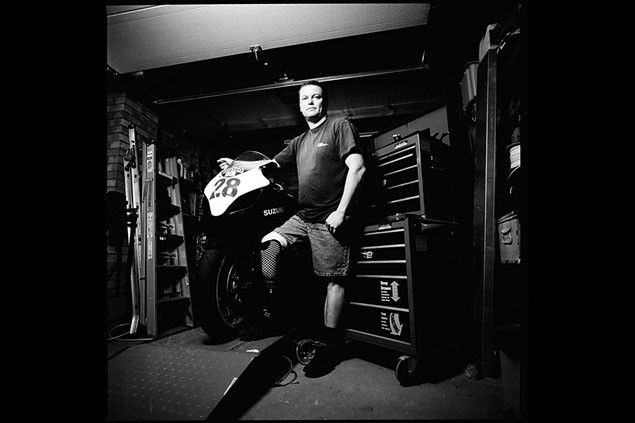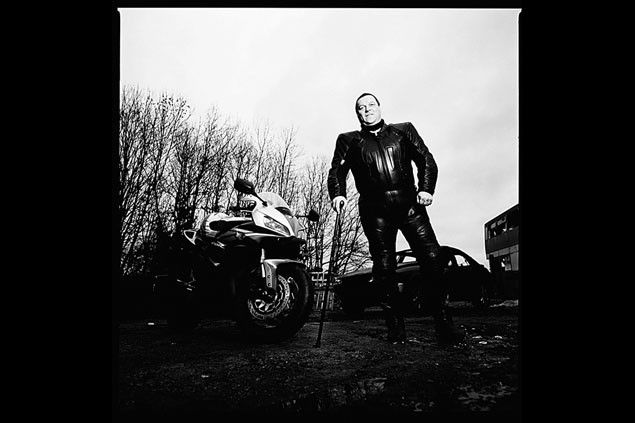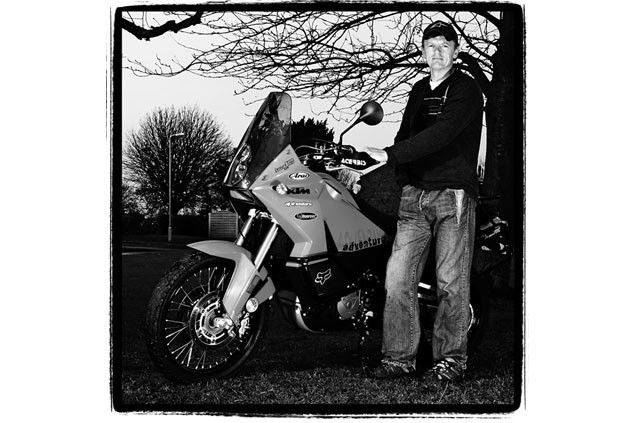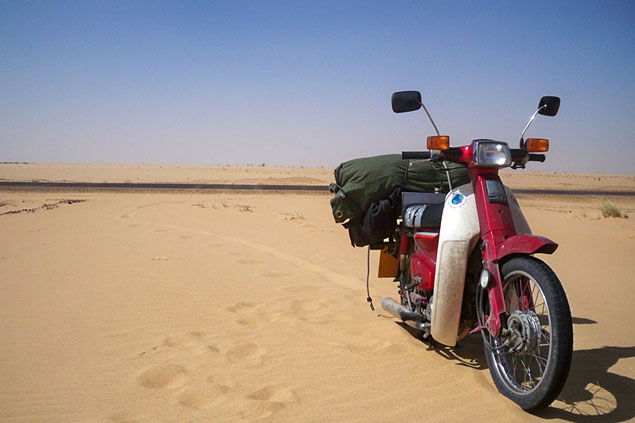True Grit - Bikers with disability
Getting hurt, badly hurt, on your bike isn’t something any of us like to talk about. But it happens. And not always to the other guy.


Chris Jones
Getting hurt, badly hurt, on your bike isn’t something any of us like to talk about. But it happens. And not always to the other guy. But just how far would you be prepared to go to get back on a bike after a serious accident? We talk to four incredibly brave souls who wouldn’t let their love of riding be stopped by anything - not even the loss of a limb...
Chris Jones is 41. One morning in June 1995 he was stationary at the end of a mile-long straight on his Honda CBR600. He had his indicator on, about to make a turn, when he was hit from behind by a car doing nearly 90mph.
I was at a standstill at the end of a long road with my CBR600’s indicator on. The car that hit me was going pretty much flat-out, not looking where he was going.
“It was strange: the impact didn’t throw me far but the bike went for miles. I was conscious throughout, and I knew my right leg was broken – it was in a proper state. I was booked to go to the Bol d’Or and I remember thinking ‘for fuck’s sake, I can’t get this leg fixed in time to go.’ I’d broken legs before, so I knew it would be tricky.
“I had to have the right leg amputated below the knee to start with because they’d lost the main artery. Then a week later gangrene set in; the knee was destroyed anyway, so they had to do it above the knee. I figured that I was pretty lucky really – at least it wasn’t my gear lever leg. I was in
hospital for about two weeks and after the operation I was on morphine for a few days – I was pretty much out of it. As soon as the fog cleared I began working out how to adapt a bike so I could ride again. I was a bit undecided at one point, but then I realised the decision was simple: I didn’t want some arsehole ruining my fun.
“I went into counselling, which did more harm than good. This woman told me I should take up wheelchair basketball – I don’t bloody like basketball! I was seething for a week. It made me angry to think I’d have bikes taken away from me, so I decided to have a bike adapted so I could get my life back. A few months after the amputation I bought a Yamaha scooter. Before I got my artificial leg I used to take my crutches with me so I could go and pay for fuel. Good friends and a sense of humour are so important. My mates give me no quarter and take the piss, but I couldn’t have done it all without them. One of them – Kevin – helps me adapt bikes. He’s a star.
“The NABD helped me big time, but the main thing for the individual is to decide whether they want to ride or not and then go through the NABD grant application system. The big thing is getting a ‘good limb’. When we meet it is like bikers talking about their bikes; ‘What leg have you got there, mate?’ , that sort of thing.
“Some of the things you have to get used to are pillions jumping off the wrong side of the bike, the side with the false leg on – that puts you right on your arse. Tight junctions on my Spondon are tricky too since it’s got so little steering lock; people often don’t understand what the problem is. Deep gutters are also a pain when you pull over – you take this stuff for granted with two legs, but you have to be careful. I have a bike land on me about once a year at least, but I don’t let it stop me.
“Kev and I were on the Isle of Man when the Fast Eddie Enduro was on, so we entered it. That was hard, a seven-mile lap, and when we turned up we were the only ones with numberplates on our bikes. Everyone else had spare bikes, wheels and proper tyres. We knew then we were screwed but we just did it for a laugh. I lasted longer than Kev though. He was winded after a crash and had to pull out and I crashed a bit later. As the marshal was pulling the bike off me I could hear the wife shouting at them, telling them I only had one leg. You’ve got to give it a go, haven’t you?
“The guy who hit me was a truck driver, so he pleaded for his licence and got eight points and a £400 fine. That’s disgraceful. While I was lying in the road, he just sat in his car. The compensation took four or five years to come through as the bastards at his insurance company fought it all the way. If just one person reads this article and decides to get back on bikes after a big crash, that will be great. If you want to do it, go for it – you won’t regret it.”
Chris Jones’ bikes
“After the BWs scooter, the first bike I bought was an FJ1200 Yamaha, but it was too heavy so within a week I swapped it for a 1991 FZR1000 EXUP. Now I’ve got a mint Honda NC30 with a heel brake. I’ve also got an Aprilia SR125 scooter with a 172cc big-bore kit, a Honda CRF230, a 2002 Yamaha R1 and a Spondon Monster GSX-R1260. The R1 rear brake has a JRC racing thumb brake from Speedycom.com. The CRF has a Honda VTR1000 FireStorm clutch master cylinder on the left-hand bar. It’s a ten-minute job but it works brilliantly.”
Gerry Murphy

Gerry Murphy
Gerry Murphy is 38 years old. Back in 1996 he was riding his ZZ-R600 on the A12 near Romford when he suffered a life-changing accident.
It was about 8pm and I was out riding with my wife of the time on the back. It wasn’t too busy and we were approaching a set of traffic lights. In the opposite direction in the filter lane the car ahead just turned right into the side of me – he’d jumped the red light. I hit the horn but by then it was too late. The car hit me in the right leg. I was conscious all the time but I don’t remember much until I stopped bouncing down the road.
“Next thing I know I’m lying on my side, propped up on my left elbow. I’m trying to get my helmet off and I’m puzzled as to why I can’t, so I look down to see my right wrist flapping in the wind. Not that I could see it, but I’d also broken my right femur and fibula and had a compound break of the tibia. At some point I’d somersaulted,and bits of bone had come off my foot, which had got trapped underneath my leg. The slide had ground through my boot and taken the top part of my foot off and then ground down some of the bones too. My ex-wife had a compound right fracture of the femur and a broken ankle.
“Luckily we’d nipped past an ambulance earlier in the journey and they were on the scene just a minute or two after the crash. I was taken to Oldchurch Hospital where they put a cast on my wrist, a pin on the thigh and an external fixator on my ankle. I was moved to Billericay hospital for skin grafting and then to Harlow where they had a surgeon who specialised in rebuilding broken legs.
“I had a frame on the leg for ten months from May that year through to the following February and it simply didn’t work. The bottom of the bones just wouldn’t fuse together. The thing with these frames is they have holes in the skin which get infected easily. With me the infection went into the bone a few times. I was on antibiotics so many times and the pain was enormous.
“Things came to a head with an off-the-cuff remark when I was finally allowed to have elbow crutches. I was in the kitchen and one of them snapped and I fell onto some stairs – it was so bloody painful. I said to my wife, ‘I wish they would just chop the bloody thing off ’. She told me to ask them about it. The diagnosis was that I could spend another year in pain, not working, and then – maybe – I’d eventually walk, but only in pain. Amputation would be three months, and then back at work. For me it was a no-brainer, but the doctor told me to sleep on it. I did but the answer was still yes. I had a below-the-knee amputation 11 months to the day after the accident in February 1996.
“There was never any feeling that I wouldn’t ride again. I discussed it in hospital with the lad in the bed next to me, who was in for a football injury. I was already thinking of spending my compensation on a Ducati, but something for the track. I got my first leg at the start of April but waited until the following summer to get a bike as it was then that I felt I could bend my leg enough to sit on a bike. There was no big emotional deal about getting back on the bike – now I just don’t like riding on the road as much as I used to.
“That’s why I started doing track days. What have helped are the advanced rider courses I’ve done since the crash. They’re worthwhile as they help you recognise dangers, learning how to maximise your progress and increase your observational skills. I guess what happened to me shows you have no idea what the other idiot is going to do. It took me eight years to get some compensation. The other bloke was an uninsured driver from Southend. He got six points and a £120 fine.”
Gerry Murphy’s bikes
“The first bike I bought was a Kawasaki GT750 that kept going wrong so I borrowed a CBR600F from the shop, but I found it uncomfortable. In the end the shop let me have a Yamaha Diversion instead. I went to the US for a while and sold both bikes, but within two weeks of my return I bought a KTM Duke, which I put a thumb rear brake on, and later a BMW1150GS. I did a Cadwell Park race school before the crash and loved it, so took the Duke out on track but a mate blew it up. I then spotted a GSX-R600K4 going cheap and bought it, put a thumb rear brake on it and used it for commuting.”
John Brown

John Brown
John Brown is from Walsall in the West Midlands. He’s 48 years old. In 2007 he was knocked off his bike while doing just 25mph in traffic.
It was about 7am and I was in this queue of traffic, pootling along on my Armstrong. A guy in an oncoming car thought there was a gap in the traffic and turned across in front of me, trying to nip through the gap. The driver’s doorpost took my left leg off above the knee. It acted like a guillotine and pushed the femur up through my pelvis. At first I felt like I was just going to get up and swap insurance details with the driver. Then the artery started giving it loads, and I realised I couldn’t get up as I was lying on my leg.
“Up until that point I was a motorcycle paramedic, so I knew I had about a minute to get some pressure on it. Thankfully an off duty copper helped me. I didn’t think I was going to make it. I had to have three litres of fluids and eight units of blood; they even got a doctor out to work on me at the roadside.
“They nearly lost me then, and again later at the hospital on the operating table. I wanted them to get Justine, my wife, so I could say ta-ra to her while I had the chance. I woke up at 5pm that evening in intensive care with my wife and friends around me. She was in bits. I knew I’d lost my leg but I didn’t know that the pelvis was shattered – it later had to be pinned and plated, but they couldn’t touch it for two weeks and that was the worst pain ever. Professor Keith Porter worked on my leg and he asked my permission for pictures of my leg injury to be used by surgeons in Iraq, as the damage done was similar to that found in blast injuries from mines.
“I was in hospital for two months, and in that time my friends had chipped in and converted my 2006 Fireblade with a Clicktronic push-button gear shifter. I felt that if I couldn’t get back on a bike I’d lost more than my leg, so two days after leaving hospital I rode the Blade. Justine knew how much it meant to me as she rides too.
“When I went for the ride I didn’t have a leg, just the stump, so with my leathers flapping in the wind I got back out on my Blade. That first ride took me back past the junction I’d nearly died on – it was so close to home I couldn’t avoid it. With all that I had been through I could only ride for four short miles. At the end I was totally done for: I burst out crying, more with relief than anything else. I was physically drained but also emotionally trolleyed – it had meant that much to get back on a bike.
“I still meet people now who used to ride but gave up because of a problem. They see me and I point them to the National Association for Bikers with a Disability. That’s the message I want to get across to your readers. Most of my friends are bikers, and we share an amazing camaraderie. Sure, we all accept we’re more vulnerable on a bike, but I’m not letting this stop me. I was at the Manx last year and we’re going again this year.
“The guy who hit me was distraught at what he’d done. I asked to speak to him, as I heard from the bobbies that he wasn’t sleeping at night. I just wanted to tell him that shit happens. He was doing the same route he did every day and he made a mistake. I could forgive him because what happened was an accident, not him being an arse. They wouldn’t let me speak to him in the end for insurance reasons but I passed on my feelings through the police. It’s ironic that in the course of my job I’d had 80mph get-offs and gone through windscreens, then a slow crash takes my leg off and changes everything. I never thought I would end up like this – I figured if it didn’t work out on the bike in a big way I’d simply die. But then it was an everyday, 25mph trundle that almost did for me.”
John Brown’s bikes
“I had a quad to use on my ‘bad days’ for the first 12 months, but the converted Blade is still my main bike. I’ve since traded the quad in for the Yamaha FJR1300 with the auto clutch. I’ve got a Suzuki GT380 and a Yamaha RD250. The RD is being refurbished but the GT380 I use with the aid of my walking stick, velcroed into position, which I then push or pull for gear changes. I’m a member of the NABD but I’ve not gone for a grant from them since my friends adapted the Blade – I’d rather the grant go to someone who really needs it to get riding again.”
Neil Wood

Neil Wood
Neil Wood from Lincolnshire was just 19 when he was involved in an accident. He and his passenger are still suffering the effects of that crash today.
I was riding my DT175 with my mate on the back. It was about 5pm on September 11th, 1982, and I was coming out of Lincoln. I’d just had the MOT done but the gearing wasn’t right, so I’d been to the local Yamaha dealer to get a new front sprocket. We were heading up to some traffic lights, which was on a bit of a bend, doing no more than about 25mph. I was in the outside lane and a car came towards us from the opposite side of the road. The woman driving clearly didn’t look where she was going because she began to turn and hit us almost head-on. Her A-pillar hit the handlebar and it broke my right arm and right leg. My mate also broke his right leg.
“I was knocked out, and when I came round I could hear my mate shouting at me as he didn’t know if I was alive or not. I don’t remember much, but my arm was like a balloon. I had loads of X-rays and spent about a month in hospital as I couldn’t get around easily with the injuries I had. I couldn’t use crutches so I just hopped around on one leg. It turned out I had a brachial plexus injury, which is quite common in bike accidents. The upshot of it was that my right arm was paralysed thanks to damage to vital nerves.
“Despite what had happened I didn’t want to stop being involved with bikes. I’ve always had mates who are bikers, and I’ve always had bikes. I was planning to race before the accident so I decided to do it anyway. I raced for years in off-road, enduros and the like. I’ve since given it up – it’s expensive and I couldn’t get the sponsorship I needed to continue. I enjoyed it though. I converted my bikes myself, without help from anyone. I have a left-hand throttle, which you push to open it, not pull. This doesn’t really take a lot of getting used to, as you have to push the throttle to be able to let the clutch out, so it’s a natural thing to do.
“Although I don’t compete any more, I still do some trials riding. I’ve done the whole road scene too – I love going to the Isle of Man, I’ve had a Streetfighter, and now I’ve got a KTM Adventure. It’s a cracking bike and I did all the conversion work myself.
“My advice to anyone who’s had a similar injury to mine is this – take one step at a time. Don’t go all-out and buy a big bike, start small – really small. Get a pushbike and get used to that first. It’s hard to get your balance, and with one arm doing all the work the general feeling is that you tend to over-steer quite a bit. It’s good to have help when you get back on, too. A close friend of mine suffered a similar injury, but to the other arm. I nurtured him, took him under my wing so to speak and he rides and races now. It’s a good feeling to help others, as you’ve been through it and you know what they’re experiencing.
“Twenty-six years on and it’s not just me who’s still living with the aftermath of a crash that wasn’t my fault. My mate who broke his leg had infection set in. He was on crutches for pretty much five years. The leg broke a further two times thanks to the weakness caused by the infection. He was told a month ago that they now want to amputate it. That’s bloody awful. We were doing less that 25mph at the time and both of us suffered debilitating injuries.
“The 65-year-old woman who hit us got a £50 fine for driving without due care and attention. That’s dreadful when you think of it. It makes me mad sometimes.”
The National Association for Bikers with a Disability was formed in 1991, when six hard-headed bikers from Stockport and Manchester decided that motorcycles shouldn’t be off limit to disabled people. They formed a registered charity and initially decided to look at ways in which they could adapt bikes for use by disabled riders. Within a year the membership had grown to 100, and today the association has more than 5,000 members and has helped more than 7,000 disabled people to enjoy biking again. Celebrity patrons include Billy Connolly and Neil Hodgson. Similar groups have been set up around the world, following the success of the NABD. If you want more information on the association, visit their website at nabd.org.uk

